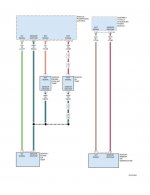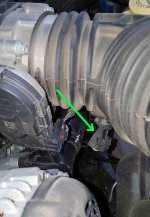You are using an out of date browser. It may not display this or other websites correctly.
You should upgrade or use an alternative browser.
You should upgrade or use an alternative browser.
HELP!!!! Code P1404 and P0113
- Thread starter wolfy
- Start date
notnalc68
That dude from Mississippi
Check engine just lit up yesterday
Any ideas if i should just clear the codes or replace the egr??
I'm no mechanic, but sounds like a bad sensor. Here's a list of the codes.
http://www.quadratec.com/jeep_knowledgebase/article-139.htm
I have an 08 JK and used to get the check engine light and it said something to do with the EGR. I washed the engine compartment and the light cleared on its own. I ran in a lot of dusty areas and it occured every once in a while. Just cleaned the engine when it did and haven't had any problems for a while now.
Check engine just lit up yesterday
Any ideas if i should just clear the codes or replace the egr??
Model year would help.
P0113-INTAKE AIR TEMPERATURE SENSOR 1 CIRCUIT HIGH
For a complete wiring diagram, refer to the Wiring Information.

Theory of Operation
Intake Air Temperature Sensor performance looks at the outputs of three temperature sensors and compares them under cold start conditions. Following a start to run delay time, the outputs of the Ambient, Engine Coolant and Intake Air Temperature sensors will be compared. If the Engine Coolant and Ambient Air Temperature Sensors agree, and the Intake Air Temperature does not agree, the Intake Air Temperature Sensor is declared as irrational. If declared irrational a second comparison will be done after a short drive cycle.
When Monitored: With the ignition on and the battery voltage greater than 10.4 Volts.
Set Condition: The Powertrain Control Module (PCM) detects that the Intake Air Temperature (IAT) Sensor input voltage is above the maximum acceptable value.
POSSIBLE CAUSES
(K21) IAT SIGNAL CIRCUIT SHORTED TO VOLTAGE
(K21) IAT SIGNAL CIRCUIT OPEN
(K900) SENSOR GROUND CIRCUIT OPEN OR HIGH RESISTANCE
INTAKE AIR TEMPERATURE (IAT) SENSOR
POWERTRAIN CONTROL MODULE (PCM)
Always perform the Pre-Diagnostic Troubleshooting procedure before proceeding. (Refer to 28 - DTC-Based Diagnostics/MODULE, Powertrain Control (PCM) - Standard Procedure).
Diagnostic Test
1.DIAGNOSTIC TROUBLE CODE (DTC) IS ACTIVE
1. Start the engine and allow it to reach normal operating temperature.
WARNING:
When the engine is operating, do not stand in direct line with the fan. Do not put your hands near the pulleys, belts or fan. Do not wear loose clothing. Failure to follow these instructions may result in possible serious or fatal injury.
2. Using the scan tool, select View DTCs.
Is the status Active for this DTC?
Yes
Go To 2
No
Perform the INTERMITTENT CONDITION diagnostic procedure. (Refer to 28 - DTC-Based Diagnostics/MODULE, Powertrain Control (PCM) - Standard Procedure).
2.(K21) IAT SIGNAL CIRCUIT SHORTED TO VOLTAGE
1. Turn the ignition off.
2. Disconnect the Intake Air Temperature (IAT) Sensor harness connector.
3. Disconnect the PCM C2 harness connectors.
4. Turn the ignition on.
5. Measure the voltage of the (K21) IAT Signal circuit in the IAT Sensor harness connector.
Is there any voltage present?
Yes
Repair the (K21) IAT Signal circuit for a short to voltage.
Perform the POWERTRAIN VERIFICATION TEST. (Refer to 28 - DTC-Based Diagnostics/MODULE, Powertrain Control (PCM) - Standard Procedure).
No
Go To 3
3.(K21) IAT SIGNAL OPEN
1. Turn the ignition off.
CAUTION:
Do not probe the PCM harness connectors. Probing the PCM harness connectors will damage the PCM terminals resulting in poor terminal to pin connection. Install the GPEC Diagnostic Adaptor to perform the diagnosis.
2. Connect the Adapter, GPEC Diagnostic 10436.
3. Measure the resistance of the (K21) IAT Signal circuit between the IAT Sensor harness connector and the GPEC Adaptor.
Is the resistance below 5.0 Ohms?
Yes
Go To 4
No
Repair the open in the (K21) IAT Signal circuit.
Perform the POWERTRAIN VERIFICATION TEST. (Refer to 28 - DTC-Based Diagnostics/MODULE, Powertrain Control (PCM) - Standard Procedure).
4.(K900) SENSOR GROUND CIRCUIT OPEN OR HIGH RESISTANCE
1. Measure the resistance of the (K900) Sensor Ground circuit between the IAT Sensor harness connector and the GPEC Adaptor.
Is the resistance below 5.0 Ohms?
Yes
Go To 5
No
Repair the (K900) Sensor Ground circuit for an open circuit or high resistance.
Perform the POWERTRAIN VERIFICATION TEST. (Refer to 28 - DTC-Based Diagnostics/MODULE, Powertrain Control (PCM) - Standard Procedure).
5.INTAKE AIR TEMPERATURE SENSOR
1. Turn the ignition off.
2. Connect the PCM C2 harness connectors.
3. Connect a jumper wire between the (K21) IAT Signal circuit and the (K900) Sensor Ground in the IAT Sensor harness connector.
4. Turn the ignition on.
5. Using the scan tool, read the IAT Sensor signal voltage.
Is the voltage below 1.0 Volt with the jumper wire in place?
Yes
Replace the Intake Air Temperature Sensor in accordance with the Service Information. (Refer to 14 - Fuel System/Fuel Injection/SENSOR, Air Temperature - Removal).
Perform the POWERTRAIN VERIFICATION TEST. (Refer to 28 - DTC-Based Diagnostics/MODULE, Powertrain Control (PCM) - Standard Procedure).
No
Go To 6
6.POWERTRAIN CONTROL MODULE (PCM)
1. Using the wiring diagram/schematic as a guide, inspect the wiring and connectors between the Intake Air Temperature Sensor and the Powertrain Control Module (PCM).
2. Look for any chafed, pierced, pinched, or partially broken wires.
3. Look for broken, bent, pushed out or corroded terminals.
4. Monitor the scan tool data relative to this circuit and wiggle test the wiring and connectors.
5. Look for the data to change or for the DTC to reset during the wiggle test.
6. Perform any Technical Service Bulletins that may apply.
Were any problems found?
Yes
Repair as necessary.
Perform the POWERTRAIN VERIFICATION TEST. (Refer to 28 - DTC-Based Diagnostics/MODULE, Powertrain Control (PCM) - Standard Procedure).
No
Replace and program the Powertrain Control Module (PCM) in accordance with the Service Information. (Refer to 08 - Electrical/8E - Electronic Control Modules/MODULE, Powertrain Control - Removal).
Perform the POWERTRAIN VERIFICATION TEST. (Refer to 28 - DTC-Based Diagnostics/MODULE, Powertrain Control (PCM) - Standard Procedure).
Portions of materials contained herein are sourced from Chrysler Corporation.
Copyright 2007 - 2014 Service Repair Solutions, Inc.
For a complete wiring diagram, refer to the Wiring Information.

Theory of Operation
Intake Air Temperature Sensor performance looks at the outputs of three temperature sensors and compares them under cold start conditions. Following a start to run delay time, the outputs of the Ambient, Engine Coolant and Intake Air Temperature sensors will be compared. If the Engine Coolant and Ambient Air Temperature Sensors agree, and the Intake Air Temperature does not agree, the Intake Air Temperature Sensor is declared as irrational. If declared irrational a second comparison will be done after a short drive cycle.
When Monitored: With the ignition on and the battery voltage greater than 10.4 Volts.
Set Condition: The Powertrain Control Module (PCM) detects that the Intake Air Temperature (IAT) Sensor input voltage is above the maximum acceptable value.
POSSIBLE CAUSES
(K21) IAT SIGNAL CIRCUIT SHORTED TO VOLTAGE
(K21) IAT SIGNAL CIRCUIT OPEN
(K900) SENSOR GROUND CIRCUIT OPEN OR HIGH RESISTANCE
INTAKE AIR TEMPERATURE (IAT) SENSOR
POWERTRAIN CONTROL MODULE (PCM)
Always perform the Pre-Diagnostic Troubleshooting procedure before proceeding. (Refer to 28 - DTC-Based Diagnostics/MODULE, Powertrain Control (PCM) - Standard Procedure).
Diagnostic Test
1.DIAGNOSTIC TROUBLE CODE (DTC) IS ACTIVE
1. Start the engine and allow it to reach normal operating temperature.
WARNING:
When the engine is operating, do not stand in direct line with the fan. Do not put your hands near the pulleys, belts or fan. Do not wear loose clothing. Failure to follow these instructions may result in possible serious or fatal injury.
2. Using the scan tool, select View DTCs.
Is the status Active for this DTC?
Yes
Go To 2
No
Perform the INTERMITTENT CONDITION diagnostic procedure. (Refer to 28 - DTC-Based Diagnostics/MODULE, Powertrain Control (PCM) - Standard Procedure).
2.(K21) IAT SIGNAL CIRCUIT SHORTED TO VOLTAGE
1. Turn the ignition off.
2. Disconnect the Intake Air Temperature (IAT) Sensor harness connector.
3. Disconnect the PCM C2 harness connectors.
4. Turn the ignition on.
5. Measure the voltage of the (K21) IAT Signal circuit in the IAT Sensor harness connector.
Is there any voltage present?
Yes
Repair the (K21) IAT Signal circuit for a short to voltage.
Perform the POWERTRAIN VERIFICATION TEST. (Refer to 28 - DTC-Based Diagnostics/MODULE, Powertrain Control (PCM) - Standard Procedure).
No
Go To 3
3.(K21) IAT SIGNAL OPEN
1. Turn the ignition off.
CAUTION:
Do not probe the PCM harness connectors. Probing the PCM harness connectors will damage the PCM terminals resulting in poor terminal to pin connection. Install the GPEC Diagnostic Adaptor to perform the diagnosis.
2. Connect the Adapter, GPEC Diagnostic 10436.
3. Measure the resistance of the (K21) IAT Signal circuit between the IAT Sensor harness connector and the GPEC Adaptor.
Is the resistance below 5.0 Ohms?
Yes
Go To 4
No
Repair the open in the (K21) IAT Signal circuit.
Perform the POWERTRAIN VERIFICATION TEST. (Refer to 28 - DTC-Based Diagnostics/MODULE, Powertrain Control (PCM) - Standard Procedure).
4.(K900) SENSOR GROUND CIRCUIT OPEN OR HIGH RESISTANCE
1. Measure the resistance of the (K900) Sensor Ground circuit between the IAT Sensor harness connector and the GPEC Adaptor.
Is the resistance below 5.0 Ohms?
Yes
Go To 5
No
Repair the (K900) Sensor Ground circuit for an open circuit or high resistance.
Perform the POWERTRAIN VERIFICATION TEST. (Refer to 28 - DTC-Based Diagnostics/MODULE, Powertrain Control (PCM) - Standard Procedure).
5.INTAKE AIR TEMPERATURE SENSOR
1. Turn the ignition off.
2. Connect the PCM C2 harness connectors.
3. Connect a jumper wire between the (K21) IAT Signal circuit and the (K900) Sensor Ground in the IAT Sensor harness connector.
4. Turn the ignition on.
5. Using the scan tool, read the IAT Sensor signal voltage.
Is the voltage below 1.0 Volt with the jumper wire in place?
Yes
Replace the Intake Air Temperature Sensor in accordance with the Service Information. (Refer to 14 - Fuel System/Fuel Injection/SENSOR, Air Temperature - Removal).
Perform the POWERTRAIN VERIFICATION TEST. (Refer to 28 - DTC-Based Diagnostics/MODULE, Powertrain Control (PCM) - Standard Procedure).
No
Go To 6
6.POWERTRAIN CONTROL MODULE (PCM)
1. Using the wiring diagram/schematic as a guide, inspect the wiring and connectors between the Intake Air Temperature Sensor and the Powertrain Control Module (PCM).
2. Look for any chafed, pierced, pinched, or partially broken wires.
3. Look for broken, bent, pushed out or corroded terminals.
4. Monitor the scan tool data relative to this circuit and wiggle test the wiring and connectors.
5. Look for the data to change or for the DTC to reset during the wiggle test.
6. Perform any Technical Service Bulletins that may apply.
Were any problems found?
Yes
Repair as necessary.
Perform the POWERTRAIN VERIFICATION TEST. (Refer to 28 - DTC-Based Diagnostics/MODULE, Powertrain Control (PCM) - Standard Procedure).
No
Replace and program the Powertrain Control Module (PCM) in accordance with the Service Information. (Refer to 08 - Electrical/8E - Electronic Control Modules/MODULE, Powertrain Control - Removal).
Perform the POWERTRAIN VERIFICATION TEST. (Refer to 28 - DTC-Based Diagnostics/MODULE, Powertrain Control (PCM) - Standard Procedure).
Portions of materials contained herein are sourced from Chrysler Corporation.
Copyright 2007 - 2014 Service Repair Solutions, Inc.
wolfy
Member
Model year would help.
It's a 2010 with the 3.8 engine and it's a 2 door islander
wolfy
Member
Unplugged sensor or an open sensor would be the first thing to check.
Get a DVOM and check the ohm's value across the sensor terminals,
at the sensor with it unplugged.
It could have a broken wire inside the wire insulation too!
I'm new to all this are there some pictures ?? You can show me the locations of those sensors?

